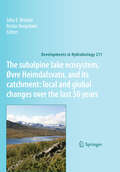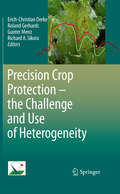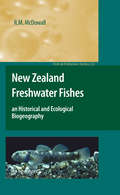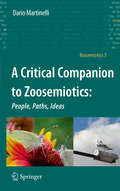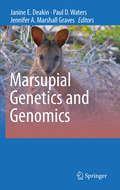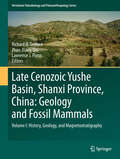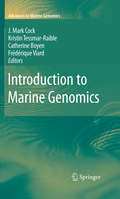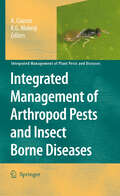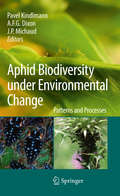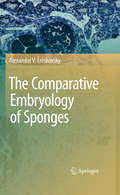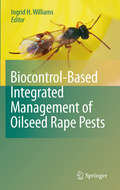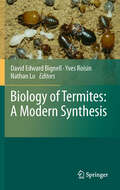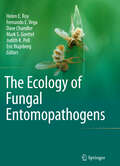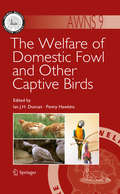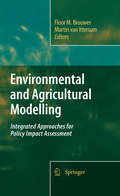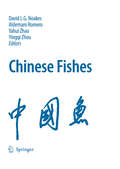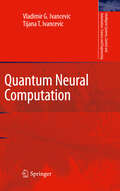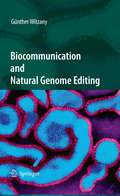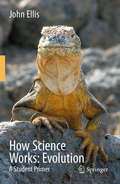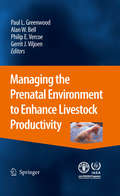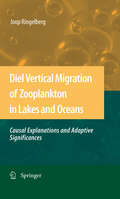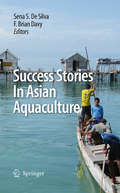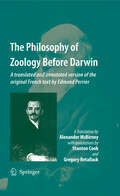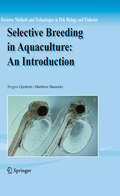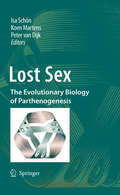- Table View
- List View
The subalpine lake ecosystem, Øvre Heimdalsvatn, and its catchment: local and global changes over the last 50 years (Developments in Hydrobiology #211)
by John E. Brittain Reidar BorgstrømPrecision Crop Protection - the Challenge and Use of Heterogeneity: The Challenge And Use Of Heterogeneity
by Erich-Christian Oerke Roland Gerhards Gunter Menz Richard A. SikoraPrecision farming is an agricultural management system using global navigation satellite systems, geographic information systems, remote sensing, and data management systems for optimizing the use of nutrients, water, seed, pesticides and energy in heterogeneous field situations. This book provides extensive information on the state-of-the-art of research on precision crop protection and recent developments in site-specific application technologies for the management of weeds, arthropod pests, pathogens and nematodes. It gives the reader an up-to-date and in-depth review of both basic and applied research developments. The chapters discuss I) biology and epidemiology of pests, II) new sensor technologies, III) applications of multi-scale sensor systems, IV) sensor detection of pests in growing crops, V) spatial and non-spatial data management, VI) impact of pest heterogeneity and VII) precise mechanical and chemical pest control.
New Zealand Freshwater Fishes: an Historical and Ecological Biogeography (Fish & Fisheries Series #32)
by R.M. McDowallIn many ways, this book is the culmination of more than four decades of my exp- ration of the taxonomy, biogeography and ecology of New Zealand’s quite small freshwater fish fauna. I began this firstly as a fisheries ecologist with the New Zealand Marine Department (then responsible for the nation’s fisheries research and mana- ment), and then with my PhD at the Museum of Comparative Zoology at Harvard University, Cambridge, MA, USA in the early–mid 1960s. Since then, employed by a series of agencies that have successively been assigned a role in fisheries research in New Zealand, I have been able to explore very widely the natural history of that fauna. Studies of the fishes of other warm to cold temperate southern lands have followed, particularly southern Australia, New Caledonia, Patagonian South America, the Falkland Islands, and South Africa and, in many ways, have provided the rather broader context within which the New Zealand fauna is embedded in terms of geography, phylogeny, and evolutionary history, and knowing this context makes the patterns within New Zealand all the clearer. An additional stream in these studies, in substantial measure driven by the beh- ioural ecology of these fishes round the Southern Hemisphere, has been exploration of the role of diadromy (regular migrations between marine and freshwater biomes) in fisheries ecology and biogeography, and eventually of diadromous fishes wor- wide.
A Critical Companion to Zoosemiotics: People, Paths, Ideas (Biosemiotics #5)
by Dario MartinelliA critical companion of zoosemiotics is the first attempt to systematise the study of animal communication and signification through its most important and/or problematic terms and concepts, and its most representative scholars. It is a companion, in that it attempts to cover the entire range of key terms in the field, and it's critical, in that it aims not only to describe, but also to discuss, problematise and, in some cases, resolve, these terms.
Marsupial Genetics and Genomics
by Janine E. Deakin Paul D. Waters Jennifer A. Marshall GravesMarsupials belong to the Class Mammalia, sharing some features with other mammals, yet they also possess many unique features. It is their differences from the more traditionally studied mammals, such as mice and humans, that is of greatest value to comparative studies. Sequencing of genomes from two distantly related marsupials, the short grey-tailed opossum from South America and the Australian tammar wallaby, has launched marsupials into the genomics era and accelerated the rate of progress in marsupial research. With the current worldwide concern for the plight of the endangered Tasmanian devil, marsupial genetics and genomics research is even more important than ever if this species is to be saved from extinction. This volume recounts some of the history of research in this field and highlights the most recent advances in the many different areas of marsupial genetics and genomics research.
Late Cenozoic Yushe Basin, Shanxi Province, China: Volume I:History, Geology, and Magnetostratigraphy (Vertebrate Paleobiology and Paleoanthropology)
by Richard H. Tedford, Zhan-Xiang Qiu and Lawrence J. FlynnThe Late Cenozoic Yushe Basin, Shanxi Province, China embodies the bulk of our knowledge on successions of terrestrial vertebrates in the northern part of East Asia. Everything we know about Asian mammals of the last 6 million years has a historical basis in the documentation of the geology of Yushe. This volume introduces the basin in its geological setting, describes the succession of fossiliferous strata, and shows how it is dated. It develops an unsurpassed level of precision for its age control. Geological maps and stratigraphic sections provide the backbone for individual studies to follow on varied fossil groups. The volume explores the history of exploration of the last century in Yushe Basin and places development of paleontology there into the context of the birth of the modern epoch of science in China.
Introduction to Marine Genomics (Advances in Marine Genomics #1)
by J. Mark Cock Kristin Tessmar-Raible Catherine Boyen Frédérique ViardMarine biology has always played an important role in biological research, being at the origin of many key advances. To a certain extent, the influence of marine biology on the biological sciences was overshadowed over a period of several years by the remarkable advances that were made using powerful model organisms from terrestrial environments. This situation is now changing again, however, due primarily to spectacular developments in genomic methodologies that have significantly accelerated research in a broad spectrum of marine biology disciplines ranging from biodiversity to developmental biology to biotechnology. The data generated by marine genomics projects have had an impact on questions as diverse as understanding planetary geochemical cycles, the impact of climate change on marine fauna and flora, the functioning of marine ecosystems, the discovery of new organisms and novel biomolecules, and investigation of the evolution of animal developmental complexity. This book represents the first attempt to document how genomic technologies are revolutionising these diverse domains of marine biology. Each chapter of this book looks at how these technologies are being employed in a specific domain of marine research and provides a summary of the major results obtained to date. The book as a whole provides an overview of marine genomics as a discipline and represents an ideal starting point for exploring this rapidly developing domain.
Integrated Management of Arthropod Pests and Insect Borne Diseases (Integrated Management of Plant Pests and Diseases #5)
by Aurelio Ciancio K. G. MukerjiThis is the last volume of the IPMD series. It aims, in a multi-disciplinary approach, at reviewing and discussing recent advances and achievements in the practice of crop protection and integrated pest and disease management. This last effort deals with management of arthropods, and is organized with a first section on biological control in citrus orchards, a second one on advanced and integrated technologies for insect pest management and a last section, dealing with mites and their biological control. A wide and exaustive literature already covers several aspects of chemical or biological control of insects and mites, but there is still a need for a more holistic vision of management, accounting for different problems and solutions, as they are applied or developed, in different regions and cropping systems, worldwide. In this series we attempted to fill this gap, providing an informative coverage for a broad range of agricultural systems and situations.
Aphid Biodiversity under Environmental Change: Patterns and Processes
by Pavel Kindlmann A.F.G. Dixon J. P. MichaudThis book presents the results of recent research on aphid population dynamics and ecology relevant to current environmental changes resulting from global wa- ing. It incorporates a selection of the contributions presented at the International Symposium on Aphids in Fremantle, Australia, in October 2005, plus some ad- tional invited chapters. The objective was to incorporate the major issues in the ?eld and simultaneously create a closely interrelated and integrated volume. The ?rst chapter sets the scene. Kindlmann and Dixon present a critical review of existing models of aphid population dynamics, examine the biological assumptions that are incorporated in the models and present one of the latest models of aphid metapopulation dynamics. They conclude that natural enemies are unlikely to affect aphid population dynamics late in a season, but in some years may have an effect very early in the season, when aphid colonies are still small and predators might be able to reduce the numbers of colonies. The question, whether aphids will move to different locations, adapt to the change in conditions in their current habitat or go extinct is discussed by Ameixa. She concludes that the distributions of aphids are most likely to change, with the distribution of each species moving globally as their preferred habitat moves in response to changes in the climate, which may be more dif?cult than in the past because of habitat fragmentation and habitat loss.
The Comparative Embryology of Sponges
by Alexander V. EreskovskyOne of the major questions in the evolution of animals is the transition from unicellular to multicellular organization, which resulted in the emergence of Metazoa through a hypothetical Urmetazoa. The Comparative Embryology of Sponges contains abundant original and literary data on comparative embryology and morphology of the Porifera (Sponges), a group of 'lower Metazoa'. On the basis of this material, original typization of the development of Sponges is given and the problems concerning origin and evolution of Porifera and their ontogenesis are discussed. A morphogenetic interpretation of the body plan development during embryogenesis, metamorphosis and asexual reproduction in Sponges is proposed. Special attention is given to the analysis of characteristic features of the ontogenesis in Porifera. The book pursues three primary goals: 1) generalization of all existing information on individual development of sponges, its classification and a statement according to taxonomical structure of Porifera; 2) revealing of heterogeneity of morphogenesis and peculiarities of ontogeneses in various clades of Porifera, and also their correlations with the organization, both adult sponges, and their larvae; 3) revealing homology of morphogeneses in both Porifera and Eumetazoa, testifying to the general evolutionary roots of multicellular animals, and peculiar features of sponges' morphogeneses and ontogenesis. This book will be of interest to embryologists, zoologists, morphologists and researchers in evolutionary biology.
Biocontrol-Based Integrated Management of Oilseed Rape Pests
by Ingrid H. H. WilliamsOilseed rape is a major arable crop in both Europe and North America. It is attacked by unique complexes of insect pests still largely controlled through the application of chemical insecticides. Crop management systems for the future must combine sustainability with environmental acceptability to satisfy both social and economic demands. This book, in its 17 chapters each led by a world expert, reviews research progress towards developing integrated pest management systems for the crop that enhance conservation biocontrol. This approach is particularly timely because of the development in Europe of insecticide resistance in the pollen beetle, a major pest of the crop. The past decade has seen considerable progress in our knowledge of the parasitoids and predators that contribute to biocontrol, of their distribution patterns, and their behavioural ecology, both within and without the crop. There is potential for natural enemy conservation through modification of within-field crop husbandry practices, as well as, on the landscape scale, through habitat manipulation to encourage vegetational diversity. This book will prove invaluable as a text for researchers, university teachers, graduate scientists, extension workers and growers involved in integrated pest management.
Biology of Termites: a Modern Synthesis
by David Edward Edward Bignell, Yves Roisin and Nathan LoBiology of Termites, a Modern Synthesis brings together the major advances in termite biology, phylogenetics, social evolution and biogeography. In this new volume, David Bignell, Yves Roisin and Nathan Lo have brought together leading experts on termite taxonomy, behaviour, genetics, caste differentiation, physiology, microbiology, mound architecture, biogeography and control. Very strong evolutionary and developmental themes run through the individual chapters, fed by new data streams from molecular sequencing, and for the first time it is possible to compare the social organisation of termites with that of the social Hymenoptera, focusing on caste determination, population genetics, cooperative behaviour, nest hygiene and symbioses with microorganisms. New chapters have been added on termite pheromones, termites as pests of agriculture and on destructive invasive species.
The Ecology of Fungal Entomopathogens
by Dave Chandler Judith K. Pell Eric Wajnberg Helen E. Roy Fernando E. Vega Mark S. GoettelUnderstanding of the ecology of fungal entomopathogens has vastly increased since the early 1800’s, but remains challenging. The often complex interactions between pathogen and host are being unravelled through eloquent research and the importance of the often subtle interactions, in determining the success or failure of biological control, cannot be underplayed. The realm of ecology is vast and deciphering insect-fungal pathogen interactions within an ecological context will take us on voyages beyond our imagination. This book brings together the work of renowned scientists to provide a synthesis of recent research on the ecology of fungal entomopathogens exploring host-pathogen dynamics from the context of biological control and beyond. Dr. Helen Roy leads zoological research in the Biological Records Centre at the NERC Centre for Ecology & Hydrology, UK. The focus of her research is insect community interactions with particular emphasis on the effects of environmental change. She has been working on the ecological interactions between fungal entomopathogens and their hosts for 15 years; this continues to be a source of fascination. She has been an associate editor of BioControl since 2006. Dr. Dave Chandler is an insect pathologist at the University of Warwick, UK. He has studied entomopathogenic fungi for just over 20 years. He has particular interests in entomopathogenic fungi as biocontrol agents of horticultural crops, fungal physiology and ecology, and the pathogens of honeybees. Dr. Mark Goettel is an insect pathologist at the Lethbridge Research Centre of Agriculture & Agri-Food Canada, specializing in the development of fungal entomopathogens as microbial control agents of insects. In addition to this research, he has been extensively involved in the review and revision of the regulations for registration of microbial control agents and has addressed regulatory and safety issues at the international level. He is currently President of the Society for Invertebrate Pathology and has been Editor-in-Chief of Biocontrol Science & Technology since 2000. Dr. Judith K. Pell heads the Insect Pathology Group in the Department for Plant and Invertebrate Ecology at Rothamsted Research, UK. She leads research on the ecology of fungal entomopathogens, to elucidate their role in population regulation and community structure and to inform biological control strategies. Specifically: intraguild interactions; the relationships between guild diversity, habitat diversity and ecosystem function; pathogen-induced host behavioural change. Dr. Eric Wajnberg is a population biologist specialising in behavioural ecology, statistical modelling and population genetics. He is also an expert in biological control, with more than 20 years experience of working with insect parasitoids. He has been the Editor in Chief of BioControl since 2006. Dr. Fernando E. Vega is an entomologist with the United States Department of Agriculture, Agricultural Research Service, in Beltsville, Maryland, USA. He conducts research on biological methods to control the coffee berry borer, the most important insect pest of coffee throughout the world. He is co-editor, with Meredith Blackwell, of Insect-Fungal Associations: Ecology and Evolution, published by Oxford University Press in 2005, and serves as an Editorial Board Member for Fungal Ecology.
The Welfare of Domestic Fowl and Other Captive Birds (Animal Welfare #9)
by Ian J. H. Duncan Penny HawkinsAnimal welfare is attracting increasing interest worldwide, especially in developed countries where the knowledge and resources are available to (at least potentially) provide better management systems for farm animals, as well as companion, zoo and laboratory animals. The key requirements for adequate food, water, a suitable environment, appropriate companionship and good health are important for animals kept for all of these purposes. There has been increased attention given to farm animal welfare in many co- tries in recent years. This derives largely from the fact that the relentless pursuit of nancial reward and ef ciency, to satisfy market demands, has led to the devel- ment of intensive animal production systems that challenge the conscience of many consumers in those countries. In developing countries, human survival is still a daily uncertainty, so that p- vision for animal welfare has to be balanced against human needs. Animal welfare is usually a priority only if it supports the output of the animal, be it food, work, clothing, sport or companionship. In principle the welfare needs of both humans and animals can be provided for, in both developing and developed countries, if resources are properly husbanded. In reality, however, the inequitable division of the world’s riches creates physical and psychological poverty for humans and a- mals alike in many parts of the world.
Environmental and Agricultural Modelling: Integrated Approaches for Policy Impact Assessment
by Floor M. Brouwer Martin IttersumAgriculture increasingly faces the challenge of balancing its multiple functions in a sustainable way. Integrated assessment and modelling (IAM) can provide insight into the potential impacts of policy changes. However, concepts to address the wide range of issues and functions typical for agriculture are still scarce. Environmental and Agricultural Modelling reviews and presents our current understanding of integrated and working tools to assess and compute, ex-ante, alternative agricultural and environmental policy options, allowing: 1. Analysis at the full range of scales (farm to European Union and global) whilst focusing on the most important issues emerging at each scale; 2. Analysis of the environmental, economic and social contributions of agricultural systems towards sustainable rural development and rural viability; 3. Analysis of a broad range of issues and agents of change, such as climate change, environmental policies, rural development options, effects of an enlarging EU, international competition, and effects on developing countries.
Chinese Fishes (Developments in Environmental Biology of Fishes #28)
by Yahui Zhao Yingqi Zhou David L. G. Noakes Aldemaro RomeroThis book documents the current state of research by Chinese scientists on fish biology and fisheries and brings together manuscripts by authors from research institutions, universities and government agencies. There are papers on aquaculture, life history, genetics, marine and freshwater biology, conservation, physiology, new species descriptions, and truly amazing hypogean fishes. The information on these remarkable cave species shows how much we have yet to learn from that incredible fauna. There are papers dealing with some of the largest fishes and some of the smallest cave species. There are papers dealing with some of the most traditional forms of aquaculture and others with the most modern molecular techniques. The volume includes papers on critically threatened native fishes as well as the most common food species, such as grass carp (Ctenopharyngodon idella). The information on rare and threatened species shows how China is dealing with their endangered fishes. The information on their carp species will be invaluable to those in other countries who will either take advantage of the productive carp species in aquaculture or try to manage them as invasive species outside China. For the first time we bring together a complete overview of the state of fisheries research in China.
Quantum Neural Computation (Intelligent Systems, Control and Automation: Science and Engineering #40)
by Vladimir G. Ivancevic Tijana T. IvancevicQuantum Neural Computation is a graduate–level monographic textbook. It presents a comprehensive introduction, both non-technical and technical, into modern quantum neural computation, the science behind the fiction movie Stealth. Classical computing systems perform classical computations (i.e., Boolean operations, such as AND, OR, NOT gates) using devices that can be described classically (e.g., MOSFETs). On the other hand, quantum computing systems perform classical computations using quantum devices (quantum dots), that is devices that can be described only using quantum mechanics. Any information transfer between such computing systems involves a state measurement. This book describes this information transfer at the edge of classical and quantum chaos and turbulence, where mysterious quantum-mechanical linearity meets even more mysterious brain’s nonlinear complexity, in order to perform a super–high–speed and error–free computations. This monograph describes a crossroad between quantum field theory, brain science and computational intelligence.
Biocommunication and Natural Genome Editing
by Günther WitzanyI wrote this book for biologists and those who are interested in both biological affairs in general and perspectives which integrate a large number of specialised biological disciplines. The theory of biocommunication presented herein investigates signal transd- tion processes among cells, tissues, organs and organisms in bacteria, animals (corals and bees), fungi and plants in the light of the current available empirical data. Because life is the central focus of the life sciences, this theory will also focus on typical features of life as opposed to inorganic matter. Because this eld of investigation is based on the methodological primacy of a pragmatic action theory, the book may also be of interest to researchers of lingu- tics, communication sciences and sociology (e.g. plant sociology, animal sociology) who would welcome an overview of these highly specialised biological disciplines. Current molecular biology as well as cell biology investigates its scienti c object by using key terms such as genetic code, code without commas, misre- ing of the genetic code, coding, open reading frame, genetic storage medium DNA, genetic information, genetic alphabet, genetic expression, messenger RNA, ce- to-cell communication, immune response, transcription, translation, nucleic acid language, amino acid language, recognition sequences, recognition sites, protein coding sequences, repeat sequences, signalling, signal transduction, signalling codes, signalling pathways, etc.
How Science Works: A Student Primer
by R. John EllisEvolution is just a theory, isn’t it? What is a scientific theory anyway? Don’t scientists prove things? What is the difference between a fact, a hypothesis and a theory in science? How does scientific thinking differ from religious thinking? Why are most leading scientists atheists? Are science and religion compatible? Why are there so many different religious beliefs but only one science? What is the evidence for evolution? Why does evolution occur? If you are interested in any of these questions and have some knowledge of biology, this book is for you.
Managing the Prenatal Environment to Enhance Livestock Productivity
by Paul L. Greenwood Philip E. Vercoe Alan W. Bell Gerritt J. ViljoenPrenatal life is the period of maximal development in animals, and it is well recognised that factors that alter development can have profound effects on the embryonic, fetal and postnatal animal. Scientists involved in research on livestock productivity have for decades studied postnatal consequences of fetal development on productivity. Recently, however, there has been a surge in interest in how to manage prenatal development to enhance livestock health and productivity. This has occurred largely due to the studies that show human health in later life can be influenced by events during prenatal life, and establishment of the Fetal Origins and the Thrifty Phenotype Hypotheses. This book, Managing the Prenatal Environment to Enhance Livestock Productivity reviews phenotypic consequences of prenatal development, and provides details of mechanisms that underpin these effects in ruminants, pigs and poultry. The chapters have been divided into three parts: Quantification of prenatal effects on postnatal productivity, mechanistic bases of postnatal consequences of prenatal development and regulators of fetal and neonatal nutrient supply. Managing the Prenatal Environment to Enhance Livestock Productivity is a reference from which future research to improve the level of understanding and capacity to enhance productivity, health and efficiency of livestock in developing and developed countries will evolve. It is particularly timely given the development of molecular technologies that are providing new insight into regulation and consequences of growth and development of the embryo, fetus and neonate.
Diel Vertical Migration of Zooplankton in Lakes and Oceans: causal explanations and adaptive significances
by Joop RingelbergWhatever theory may be advanced to explain diurnal migration, the underlying reactions involved must be demonstrated conc- sively in the laboratory before the explanation can be ?nally accepted George L. Clarke 1933 p. 434 In oceans and lakes, zooplankton often make diel vertical migrations (DVM), descending at dawn and coming up again in late afternoon and evening. The small animals cover distances of 10–40 m in lakes or even a few hundred metres in the open oceans. Although not as spectacular as migrations of birds or the massive movements of large mammals over the African savannas, the numbers involved are very large and the biomass exceed the bulk of the African herds. For example, in the Antarctic oceans swarms of “Krill” may cover kilometres across, with thousands of individuals per cubic metre. These Euphausiids are food for whales, the most bulky animals on earth. Zooplankton are key species in the pelagic food web, intermediary between algae and ?sh, and thus essential for the functioning of the pelagic community. Prey for many, they have evolved diverse strategies of survival and DVM is the most imp- tant one. Most ?sh are visually hunting predators and need a high light intensity to detect the often transparent animals. By moving down, the well-lit surface layers are avoided but they have to come up again at night to feed on algae.
Success Stories in Asian Aquaculture
by Sena S. Silva F. Brian Davycase studies of successful governance models could be referred to by others in order to improve the management of the sector. This is the initial step toward compiling stories of aquaculture successes, and the editorial team is to be congratulated for its great efforts. In approaching this difficult assignment, the team benefited from the leadership of the Network of Aquaculture Centres for Asia and the Pacific (NACA), and the support of the World Fisheries Trust (WFT) as well as the Institute for International Sustainable Development (IISD) of Canada. We hope that the team will continue its endeavor in producing other aquaculture success stories, also from other regions of the world. Rome, Italy Jiansan Jia Pr eface We are moving into a turbulent and an uncertain era, particularly in respect of the future food needs. Given the push to sustainability, the rise in food prices, and the impending concerns around climate change and related complexity on providing the food needs for an increasing global population, it is time to address coping strategies. It is in this context that the issue on where will aquaculture development move in the future is taken up.
The Philosophy of Zoology Before Darwin: A translated and annotated version of the original French text by Edmond Perrier
by Alex McBirney Stanton CookJean Octave Edmond Perrier was a French zoologist who lived through the tumult of British Darwinism and Lyellism, and reminds us in this revealing account that French scientists had much to contribute to such perennial topics as evolution, catastrophism and creationism. While very much a product of the Third Republic, Perrier’s account also aimed to outline timeless issues and permanent advances in taxonomic and developmental biology since classical Greece and Rome. In this aim he succeeds with surprisingly modern perspectives for a book first published in 1884. Perrier was born May 9, 1844 at Tulle, the son of the principal of a school which now bears his name, Lycée Edmond Perrier. In 1864 he was accepted to the École Normale Supérieure, where he was strongly influenced by Louis Pasteur and Henri de Lacaze-Duthiers. After working for three years at a high school in Agen, he obtained a post of naturalist-aid at the Muséum National d'Histoire Naturelle (1868), advancing in that institution to Chair of Natural History of Molluscs, Worms and Corals (1876–1903) and then Director of the museum (1900–1919) and Chair of Comparative Anatomy (1903–1921). Previous directors of the museum included many of the scientists he discusses in this book: George Cuvier (1822–1823, 1826–1827, 1830–1831), Isidore Geoffrey St Hilaire (1860– 1861), and Alphonse Milne-Edwards (1891–1900). Perrier’s own research on echinoderms and earthworms took him on several expeditions in 1880-1885, mostly to Atlantic and Mediterranean coasts, but also to the Caribbean.
Selective Breeding in Aquaculture: An Introduction (Reviews: Methods and Technologies in Fish Biology and Fisheries #10)
by Trygve Gjedrem Matthew BaranskiThe foundation of quantitative genetics theory was developed during the last century and facilitated many successful breeding programs for cultivated plants and t- restrial livestock. The results have been almost universally impressive, and today nearly all agricultural production utilises genetically improved seed and animals. The aquaculture industry can learn a great deal from these experiences, because the basic theory behind selective breeding is the same for all species. The ?rst published selection experiments in aquaculture started in 1920 s to improve disease resistance in ?sh, but it was not before the 1970 s that the ?rst family based breeding program was initiated for Atlantic salmon in Norway by AKVAFORSK. Unfortunately, the subsequent implementation of selective breeding on a wider scale in aquaculture has been slow, and despite the dramatic gains that have been demonstrated in a number of species, less than 10% of world aquaculture production is currently based on improved stocks. For the long-term sustainability of aquaculture production, there is an urgent need to develop and implement e- cient breeding programs for all species under commercial production. The ability for aquaculture to successfully meet the demands of an ever increasing human p- ulation, will rely on genetically improved stocks that utilise feed, water and land resources in an ef?cient way. Technological advances like genome sequences of aquaculture species, and advanced molecular methods means that there are new and exciting prospects for building on these well-established methods into the future.
Lost Sex: The Evolutionary Biology of Parthenogenesis
by Isa Schön Koen Martens Peter DijkSex is the queen of problems in evolutionary biology. Generations of researchers have investigated one of the last remaining evolutionary paradoxes: why sex exists at all. Given that sexual reproduction is costly from an evolutionary point of view, one could wonder why not all animals and plants reproduce asexually. Dozens of contemporary hypotheses attempt to explain the prevalence of sex and its advantages and predict the early extinction of fully asexual lineages. The major theme of this book is: what is the fate of animal and plant groups in which sex is lost? Initial chapters discuss theory behind asexual life: what major disadvantages do asexual groups have to face, what are the genetic and ecological consequences and what does this theory predict for more applied aspects of asexual life, for example in agricultural pests, diseases as well as in cultural crops such as grapes. Cases studies in many animals (focusing on both invertebrates and vertebrates) and plants reveal parallel, but also singularly novel adaptations to the absence of meiosis and syngamy. And last but not least, are asexuals really doomed to early extinction or do genuine ancient asexuals exist? This book assembles contributions from the most important research groups dealing with asexual evolution in eukaryotes. It is a milestone in research on parthenogenesis and will be useful to undergraduate as well as graduate students and to senior researchers in all fields of evolutionary biology, as the paradox of sex remains its queen of problems.
